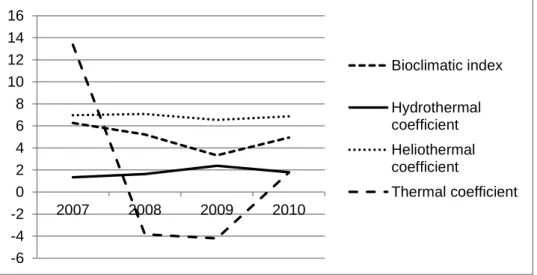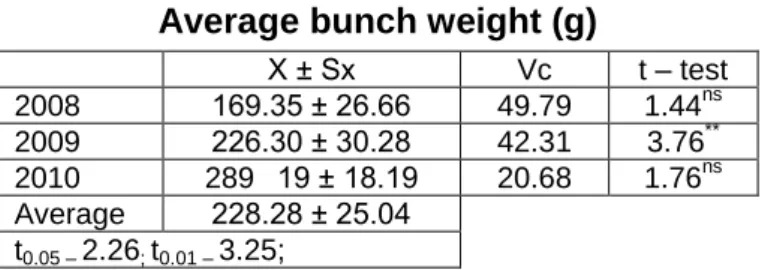178
EFFECT OF CLIMATIC PARAMETERS ON UVOLOGICAL
CHARACTERISTICS OF VARIETY ’BLATINA’
TATJANA JOVANOVIĆ-CVETKOVIĆ, DRAGUTIN MIJATOVIĆ, RADA GRBIĆ Faculty of Agriculture, University of Banja Luka, Bulevar Vojvode Petra Bojovića 1A, Banja Luka, Republic of Srpska/Bosnia and Herzegovina
Keywords: environmental parameters, bunch, 'Blatina'
ABSTRACT
The winegrowing hills of Mostar as part of the Herzegovinian winegrowing region have always been considered suitable for grapevine cultivation, mostly as a result of favorable soil and climatic conditions. Herzegovina is home to a range of ancient grapevine varieties assumed to be indigenous to Bosnia and Herzegovina, with only few of them being commercial. 'Blatina' is the most important indigenous variety in Bosnia and Herzegovina intended for red wine production. It develops functionally female flowers, and the success of its fertilization is largely dependent on climatic conditions. This paper provides the results of an analysis of major bunch and berry characteristics conducted over a three-year period. Research findings indicate a significant effect of environmental conditions on some uvological traits of the bunch and berry.
INTRODUCTION
All biological functions, cropping, grape quality and cost-effectiveness of the grapevine as a perennial plant are dependent on the habitat where it is grown. Therefore, it is necessary to thoroughly examine environmental factors in regions designed for grape production. Moreover, the analysis of these parameters is vital to choosing proper agricultural and viticultural practices to be used in existing plantings. The winegrowing hills of Mostar as part of the Herzegovinian winegrowing region are directly impacted by the Adriatic Sea and are thus characterized by a modified Mediterranean or Adriatic mountainous climate (Vuksanović and Mijatović, 1982). 'Blatina' is an indigenous red wine grape variety occurring in the region of Herzegovina. Given the general opinion that 'Blatina' is the most important trait of Herzegovinian grape growing and winemaking, it has been the subject of a number of studies not only in Bosnia and Herzegovina, but also in surrounding countries (Burić, 1985; Blesić, 2001; Rogić, 2009; Božinovik, 2010; Kojić et al., 2010; Buntić et al., 2010). 'Blatina' develops functionally female flowers that have a great impact on yield depending on year. The production of a single-variety wine from 'Blatina' has not been a regular winemaking practice. As the 'Blatina' varietal wine does not exhibit long-lasting color stability, it is recommended to blend wines made from varieties used as pollenizers in plantings (Blesić, 2001). The objective of this study was to analyze the effect of climatic parameters on uvological characteristics of the variety 'Blatina'.
MATERIAL AND METHOD
179
conditions during the research period were analyzed based on data obtained by the Federal Weather Bureau, Sarajevo. For a more thorough assessment of climatic conditions in the Mostar region, the following bioclimatic indicators of importance for grapevine cultivation were calculated: thermal coefficient, hydrothermal coefficient, heliothermal coefficient and bioclimatic index. The data obtained were subjected to calculation of the mean, standard error and coefficient of variation. The significance of differences between means was evaluated by t-test.
RESULTS AND DISCUSSION
Climatic conditions are among major factors that affect grape yield and quality and, hence, wine quality. The climatic specificity of the Mostar region exerts a particular effect on grape production and wine quality (Jovanović-Cvetković et al., 2013). The average values of mean annual and mean growing season temperatures in 2008 and 2009 were somewhat higher than the ten-year average (2000-2010), in contrast to the values in 2010 that were somewhat lower than the long-term average (Table 1).
Table 1
Basic climatic parameters in the study area
2007 2008 2009 2010 2000-2010
a. 16.1 16.1 15.7 15.2 15.6
b. 21.5 21.1 21.3 20.4 21.0
c. 1232.70 1430.00 1848.90 2544.70 1498.10
d. 401.70 607.90 741.80 1047.80 663.30
a - mean annual temperature (oC); b - mean growing season temperature (oC); c - total annual precipitation (mm); d - growing season precipitation (mm)
The analysis of precipitation totals in experimental years reveals that the total amount of precipitation in 2008 was below the long-term average, and that 2008 was the driest year during the research. The precipitation total in 2009 was above the long-term average, and 2010 was characterized by exceptionally abundant rainfall. Regardless of the absolutely high amounts of precipitation during the experimental period, most precipitation occurred at the beginning and end of the year, whereas the growing season was a drier period of the year. This unfavorable distribution of rainfall during the year led to shorter or longer dry periods which most likely imposed stress on grapevine growth and development. The analysis of temperature and precipitation data for the experimental years clearly indicatespotential specifically varied effects on the grapevine growing season, as shown through bioclimatic indicators (Graph 1).
Figure 1. Bioclimatic indicators for the study area
-6 -4 -2 0 2 4 6 8 10 12 14 16
2007 2008 2009 2010
Bioclimatic index
Hydrothermal coefficient
Heliothermal coefficient
180
There were significant differences across years in the thermal coefficient value, whichshowed marked continentality for 2009 and 2010 (like 2007) and an almost Mediterranean climate for 2008. The bioclimatic index values differed among experimental years, but they were within the range optimum for grapevine cultivation. The values of the bioclimatic index for 2008 and 2009 were within the range for the long-term average, whereas the bioclimatic index in 2010 was below the long-term average, due to high amounts of precipitation during the growing season. The high value of the bioclimatic index in 2007 indicates potentially extreme climatic events and the need for irrigation.
Given that the functional morphology of the grapevine inflorescence and flower in reproductive biology is a very important factor contributing to the effectiveness of reproductive organs towards the realization of high yields of grapes of suitable quality, particular attention in the ampelographic study of the variety ’Blatina’ was addressed to the characteristics directly affected by the degree of fertilization i.e. the bunch, the berry and the seed. The average bunch weights of’Blatina’ during the experimental period are presented in Table 2. .
Table 2
Average bunch weight (g)
X ± Sx Vc t – test
2008 169.35 ± 26.66 49.79 1.44ns
2009 226.30 ± 30.28 42.31 3.76**
2010 289 19 ± 18.19 20.68 1.76ns
Average 228.28 ± 25.04
t0.05 – 2.26; t0.01 – 3.25;
’Blatina’ had the lowest average bunch weight in 2008 (169.35 g) and the highest in 2010 (289.19 g). In terms of the research objective, ’Blatina’ showed high variations in bunch size in 2008 and 2009, as the coefficient of variation (Vc) was above 40%. The high value of the variation coefficient suggests that berry set conditions in the two experimental years were extremely variable, which may be associated with pollen transfer (lack of pollen from pollenizervarieties or poor transfer of pollen). The climatic conditions in 2010 were the most favorable for pollination and fertilization, unlike the conditions recorded in 2008 and 2009. Differing data have been obtained on bunch weight in’Blatina’, speaking in favor of the high variability of this characteristic, which is, inter alia, greatly affected by climatic parameters during experimental years.
181
Table 3
Number of berries per bunch
X ± Sx Vc t – test
2008 53.40 ± 9.59 56.79 1.16
2009 71.40 ± 12.21 54.07 1.80
2010 72.60 ± 4.61 20.07 0.09
Average 65.80 ± 8.80
t0.05 – 2.26; t0.01 – 3.25;
The coefficient of variation for the studied trait can be analyzed through general variation in some parameters in fruit tree biology, consistently with previous studies. Blesić (2001) analyzed the mechanical composition of the bunch and berry of ’Blatina’ and found 103 berries per bunch, the number being somewhat higher than in the present research. The percentage of berries in the bunch structure was variable during the experimentalperiod,and lowest in 2008 (Figure 2).
Figure 2. Mechanical composition of the bunch
As reported by Božinovik (2010), the percentage of berries in the bunch was 96%. The greatest average berry weight of ’Blatina’ (Table 4) was in 2010 (4.28 g). When evaluating the mechanical composition of the bunch and berry of ‘Blatina’, Blesić (2001) found that the 100-berry weight was 204.1g, and Rogić (2009) reported the range of 188.00 g – 192.75 g in 2008.
Table 4
Single berry weight (g)
X ± Sx Vc t – test
2008 2.88 ± 0.14 15.16 2.01
2009 3.30 ± 0.16 14.90 6.08**
2010 4.28 ± 0.18 13.61 4.07**
Average 3.49 ± 0.16 14.56
t0.05 – 2.26; t0.01 – 3.25;
Year also had an effect onflesh (Figure 3). The lowest flesh percentage was recorded in 2008 (82.61%) and the highest in 2009 (88.27%).
0.00 20.00 40.00 60.00 80.00 100.00 120.00
2008 2009 2010
Berry (%)
182
Figure 3. Mechanical composition of the berry
The average number of seeds per berry in the studied variety is presented in Table 4, and the average single seed weight is given in Table 5.
Table 4
Number of seeds per berry
X ± Sx Vc t – test
2008 1.23 ± 0.04 11.00 3.73**
2009 1.50 ± 0.06 12.30 4.13**
2010 1.81 ± 0.13 23.37 2.12
Prosek 1.51 ± 0.08
t0.05 – 2.26; t0.01 – 3.25;
The lowest number of seeds per berry was obtained in 2008 (1.23). In 2010 and 2009, the average number of seeds per berry was highly significantly greater than in 2008. These differences may be partly related to environmental conditions during the experimental years. Number of seeds per berry is a variable trait, primarily dependent on variety and degree of fertilization (Burić, 1985). Seed numbers can be highly useful in adjusting the red wine technology (Blesić, 2001). The lowest average single seed weight in ’Blatina’ was obtained in 2009 (0.0418 g), and the highest in 2010 (0.0576 g).
Table 5
Single seed weight (g)
X ± Sx Vc t – test
2008 0.0449± 0.0009 13.68 2.49*
2009 0.0418 ± 0.0009 15.25 8.46**
2010 0.0576 ± 0.0012 14.93 10.54**
Average 0.0481 ± 0.0010
t0.05 – 2.26; t0.01 – 3.25;
In the analysis of the mechanical composition of 'Blatina' bunch and berry, Blesić (2001)found that the average 100-seed weight was3.84 g. Rogić (2009) reported the range of 4.86 - 8.32 g for the average seed weight of 100 berries in ’Blatina’ grapes under different defoliation and shoot topping treatments. Towards additional description of ’Blatina’, standard ampelographic characterization was performed in accordance with the
0.00 20.00 40.00 60.00 80.00 100.00 120.00
2008 2009 2010
Flesh (%)
Skin (%)
183
primary OIV descriptors adapted to the modern variety description method (Tables 6 and 7).
Table 6
Ampelographic (morphological) characterization (OIV - Code 2nd edition 2007) – characteristics of the bunch
description grade
202 medium (160.6) 5
203 medium (122.7) 5
204 loose 3
206 very short (27.8) 1
207 more than the middle 7
208 conical 2
209 1-2 2
502 low (228.28) 3
Table 7
Ampelographic (morphological) characterization (OIV - Code 2nd edition 2007) – characteristics of the berry
description grade
220 medium (17.8) 5
221 medium (17.2) 5
222 not uniform 1
223 obloid (1.01) 1
225 blue black 6
226 uniform 2
227 high 7
228 thick 7
229 little visible 1
230 not colored 1
231 none 1
232 medium 2
233 medium 5
235 medium 5
236 none 1
238 short 3
240 difficult 3
241 complete (1.51) 3
242 medium (6.56) 5
242-2 wide (4.12) 7
243 high (48-64) 7
244 absent 1
503 medium (3.49) 5
CONCLUSIONS
184
BIBLIOGRAPHY
1.Blesić, M., 2001- Stabilnost bojenih materija I kvalitet vina u zavisnosti od uslova vođjenja maceracije kljuka Blatine. Doktorska disertacija. Poljoprivredni Fakultet Univerziteta u Sarajevu.
2.Božinovik, Z., 2010 - Ampelografija. Agrinet DOO, Skopje.
3.Buntić, M., Beljo, J., Sabljo, A., Leko, M., 2010 – Ampelografska karakterizacija genetskih izvora vinove loze, Zbornik radova XXI naučno-stručna konferencija poljoprivrede i prehrambene industrije, Neum 139-148..
4.Burić, D., 1985 – Savremeno vinogradarstvo. Nolit, Beograd.
5. Jovanović-Cvetković T., Mijatović, D., Radojević, I., 2013 – Climate characteristics of wine growing in Mostar wine area. Symposium proceedings, International symposium for agriculture and food, Skopje.Vol. I, pp. 250-253.
6. Kojić A., Blesić M., Delić M., Kovačević S., Lasić V., 2010 – Proučavanje privredno –




